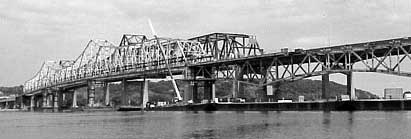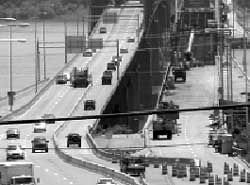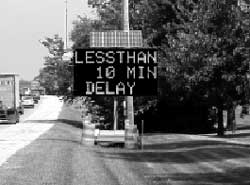Fact Sheet 5 - Innovation During Bridge Rehabilitation Improves Mobility
Winter/Spring 2001
Using the combination of a movable barrier system and interactive traffic management system, the Illinois Department of Transportation (IDOT) reduced traffic delays and driver frustrations during a $26 million rehabilitation project on the McClugage Bridge. IDOT planned this innovative approach because, historically, projects on or near the McClugage Bridge have resulted in 30-minute traffic delays. The bridge carries two major highways over the Illinois River north of downtown Peoria and on an average day approximately 42,500 vehicles cross the bridge.
 The McClugage Bridge—carrying US 150 and US 24 over the Illinois River, Peoria, Illinois |
IDOT Resident Engineer Shane Larson said, “The day the project began, the headlines in the Peoria Journal-Star read ‘D-Day on the McClugage Bridge.’ The media was waiting for traffic to back up and it didn’t.” The barrier was moved twice daily to provide two lanes of travel in the direction of peak hour traffic flow, while the portable traffic management system provided the public with information on delays and alternate routes. Mr. Larson added, “No one could believe how smoothly traffic flowed because of the past history of backups on the bridge.”
Measures Used to Manage Traffic and Reduce Delays
With the eastbound structure closed during construction, the westbound structure carried the two-way traffic using a reversible middle lane. To reduce the delays experienced by motorists, the following measures were implemented:
- The westbound structure was reconfigured twice a day using a movable
concrete barrier to accommodate rush hour traffic into Peoria in the
morning and out of the city in the evening. Two lanes were provided
for westbound traffic from 9 p.m. to 11 a.m. and two lanes for eastbound
traffic from 11 a.m. to 9 p.m.
- Motorists were alerted to traffic congestion by portable message boards and a highway advisory radio system. The portable traffic management system supplied motorists with real-time delay information and suggested alternate routes of traffic when there was a lengthy backup on the bridge. The portable traffic management system used Doppler radar speed detection equipment, a computer, variable electronic message boards, and a radio system, in combination, to provide information to the public.
 Quick Change Movable barrier. |
 ADAPTIR real time message system in advance of the McClugage Bridge. |
Work on the eastbound structure consisted of removing and replacing the bridge deck, removing and replacing the structural steel flooring system, and blasting and painting the entire structure. An innovative overhead crane system facilitated placement of the deck and movement of materials on the bridge.
According to Mr. Larson, these measures along with A+B bidding and being proactive in working with local officials and with the media helped to make this project a success. The bridge reopened October 31, 2000 with construction clean-up ending the following week.
Open House Showcased Technologies
On August 2, 2000, the IDOT District 4 Office and the Federal Highway Administration (FHWA) Illinois Division sponsored an open house in Peoria. The open house showcased, for other State agencies and FHWA representatives, the two traffic management techniques being used in the rehabilitation of the McClugage Bridge. Approximately 55 people from Illinois and surrounding States participated in the open house.
A videotape of the project and technologies used during the project will be available in January 2001. Copies of the video can be obtained by contacting the FHWA Illinois Division Office.
To learn more, contact:
Shane Larson
IDOT Resident Engineer
Illinois Department of Transportation
401 Main
Peoria, IL 61602-1111
Phone: 309-671-3333
E-mail: larsonws@nt.dot.state.il.us
Charleen Boudreau
Construction Supervising Field Engineer
Illinois Department of Transportation
401 Main
Peoria, IL 61602-1111
Phone: 309-671-3657
E-mail: boudreauca@nt.dot.state.il.us
Daniel Mathis
FHWA Assistant Division Administrator
Federal Highway Administration
3250 Executive Park Drive
Springfield, IL 62703
Phone: 217-492-4641
E-mail: Daniel.Mathis@fhwa.dot.gov
To share your Best Practices, contact:
Phillip Ditzler
Federal Highway Administration
400 Seventh Street, S.W.
Washington, DC 20590
Phone: 202-366-0855
Email: Phillip.Ditzler@fhwa.dot.gov
U.S. Department of Transportation
Federal Highway Administration
Publication No. FHWA-OP-01-008
